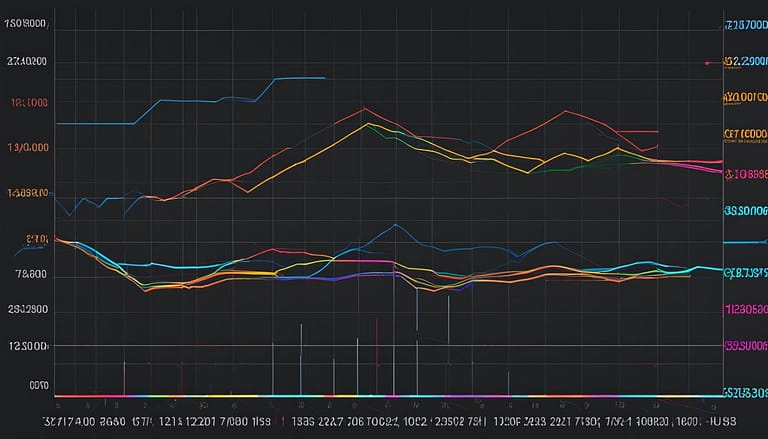Yield Farming: Earning Passive Income in DeFi
As the landscape of investment continues to evolve, Decentralized Finance (DeFi) has emerged as a revolutionary frontrunner, presenting savvy individuals with opportunities for Passive Earning. Yield farming, a prominent strategy within DeFi, empowers investors to partake in Cryptocurrency Investment endeavours that are designed to generate income through the ingenious use of DeFi Strategies. This method involves staking or lending digital assets in exchange for rewards, leveraging the capabilities of smart contracts in the secure and transparent ecosystem of DeFi.
For Canadians looking to diversify their investment portfolio in the digital asset space, yield farming offers an intriguing avenue. However, it’s accompanied by the need for a comprehensive understanding of its principles and risks. The potential for substantial returns beckons, yet it is critical to navigate this space with insight and prudence.
Key Takeaways
- Yield farming is an innovative DeFi Strategy offering Passive Earning potential through staking or lending cryptocurrencies.
- In DeFi, smart contracts facilitate the process, ensuring security and transparency for Cryptocurrency Investment.
- While offering the prospect of significant returns, investors should be aware of the risks associated with market volatility and impermanent loss.
- Platforms like Hedera are instrumental in enhancing transaction speed and security for yield farming.
- Canadian investors are advised to stay informed and practice due diligence when engaging in yield farming within Decentralized Finance.
Understanding the Basics of Yield Farming
Delving into the emerging world of decentralized finance, yield farming is revolutionizing the concept of passive earning. As an integral component of DeFi strategies, it thrives on user participation and advanced technology like smart contracts. Let’s unpack the essential elements that fuel this new era of digital finance.
What Is Yield Farming and How Does It Work?
Yield farming, in essence, is an innovative financial strategy that allows cryptocurrency holders to earn rewards by utilising their assets within the DeFi ecosystem. Users lend or stake their digital currencies on a platform, where they receive returns in various forms – whether as interest or native platform tokens. This is made possible through the seamless integration of smart contracts, which manage the distribution of rewards, reinforcing both security and efficiency.
The Role of Liquidity Providers in DeFi
The success of yield farming largely hinges on the role of liquidity providers. These individuals contribute their cryptocurrencies to liquidity pools, which serve as marketplaces for users to borrow, lend, or exchange tokens. In return for their services, liquidity providers earn transaction fees and sometimes additional rewards, which creates a robust and self-sustaining financial environment burning bright with potential for growth.
Smart Contracts: The Backbone of Yield Farming
At the heart of yield farming lies smart contracts: the automated, self-executing contracts that establish the trustless agreements essential to DeFi operations. These digital protocols facilitate all transactions, from staking to reward allocation, thus eliminating the need for intermediaries and ensuring a transparent, efficient, and secure yield farming process.
In conclusion, tapping into the realm of yield farming offers a promising avenue for passive earners to amplify their digital assets. Whether you’re a seasoned investor or a DeFi novice, understanding the synergy between liquidity providers, smart contracts, and DeFi strategies is pivotal in navigating the vast seas of decentralized finance opportunities.
Popular DeFi Protocols for Yield Farming
The world of Decentralized Finance (DeFi) is rapidly evolving, and within this realm, yield farming stands as a cutting-edge method for earning returns. The backbone of this innovation lies within the Ethereum blockchain, which, due to its formidable smart contract capabilities, has become a hub for various DeFi protocols. Among these, certain platforms have gained prominence, heralding new possibilities for yield farmers everywhere.
Ethereum and Its Dominance in DeFi
Ethereum’s pioneering role in DeFi is undeniable. Through its flexible and powerful smart contracts, it facilitates the creation of decentralized applications (dApps) that underpin the functionalities of yield farming platforms. This versatility and the network’s robust security measures have ensured that Ethereum retains its position as the leading blockchain choice for DeFi protocols.
The Rise of Protocols Like Curve Finance and Yearn.finance
Key players such as Curve Finance and Yearn.finance have redefined yield farming with their unique approaches. Curve Finance leverages specialized algorithms to provide deep liquidity, essential for stablecoin trading with minimal slippage. On the other hand, Yearn.finance excels at automating yield optimization, moving its users’ funds between the most profitable lending services seamlessly.
| Features | Curve Finance | Yearn.finance |
|---|---|---|
| Core Offering | Liquidity pools optimized for stablecoin trading | Automated yield optimization aggregator |
| Blockchain Base | Ethereum | Ethereum |
| Native Token | CRV | YFI |
| User Benefit | Low slippage and reduced risk of impermanent loss | Maximized yields through automated strategy switching |
As the DeFi space continues to expand, the contributions of Ethereum and platforms like Curve Finance and Yearn.finance enrich the ecosystem, offering investors diversified options for passive income. These protocols exemplify the innovative spirit inherent in DeFi yield farming, setting the stage for further evolution and growth within the sector.
Yield Farming on Various Blockchains
The decentralized finance landscape is rich with opportunities as yield farming takes root across various blockchains, transcending the borders set by traditional Ethereum-based applications. Pioneers of this industry have long recognized Ethereum as the nucleus of DeFi activities, but recent advancements have allowed alternative blockchains like Bitcoin and Polygon to establish their own DeFi ecosystems, each bringing distinct advantages and complexities, especially when it comes to cross-chain farming. Let’s delve into the distinguishing features of these networks and assess the burgeoning domain of cross-chain farming.
Distinguishing Features of Bitcoin, Ethereum, and Polygon Networks
When considering yield farming, the characteristics inherent to each blockchain play a pivotal role in its potential for generating returns. Ethereum, the first and most established platform in the DeFi space, boasts an exhaustive array of protocols and lending platforms. Its smart contract functionality is the backbone of the most intricate yield farming strategies. Bitcoin, traditionally not associated with DeFi, has nonetheless entered the arena with the Lightning Network, aiming to facilitate instant transactions and broader financial applications. Meanwhile, Polygon emerges as a dark horse with its promise of scalability and lower transaction costs, sweetening the yield farming deal for those deterred by Ethereum’s gas fees.
Cross-Chain Farming: Opportunities and Challenges
While each blockchain offers unique opportunities for yield farming, the real game-changer lies in cross-chain farming. This approach enables liquidity to move between different blockchains, potentially enhancing yield while diversifying risk. However, as with any innovation, cross-chain farming comes with challenges, including smart contract vulnerability across chains and the increased sophistication needed to navigate these inter-blockchain transactions. Below is a table outlining some of these challenges and opportunities:
| Blockchain | Opportunities | Challenges |
|---|---|---|
| Bitcoin (Lightning Network) | Enables instant transactions and micro-payments | Reduced smart contract flexibility compared to Ethereum |
| Ethereum | Established DeFi ecosystem with various protocols | Higher transaction fees (gas prices) |
| Polygon | Lower fees and enhanced scalability | Smaller ecosystem but growing rapidly |
| Cross-Chain Platforms | Access to broader liquidity pools and yield optimization | Increased complexity and interoperability issues |
Engaging with various blockchains presents a frontier of possibilities for yield farmers. Bitcoin’s Lightning Network offers speed, Ethereum promises a mature environment with multiple yield streams, and Polygon’s affordability makes it an attractive option for new entrants. Still, as we explore the symbiotic potential of cross-chain farming, farmers must be cognizant of the increased complexity and potential risks posed by a multi-blockchain approach. Important innovations notwithstanding, such ventures should be undertaken with due diligence and a comprehensive understanding of the DeFi ecosystem.
Dynamic Rewards in DeFi: Analyzing the Changing Rates
The DeFi landscape is a humming ecosystem where Dynamic Rewards and fluctuating DeFi Yield Rates are the norm rather than the exception. Set against an ever-evolving Cryptocurrency Market, these variable interest frameworks are compelling yet complex, drawing in seasoned investors and curious newcomers alike. The primary engine behind this flux is the ingenious use of smart contracts that adjust yields in response to a multitude of market signals.
Understanding these changes requires insights into several market dimensions. Notably, the rates depend on several variables, which include:
- The supply and demand for certain cryptocurrencies within the market.
- The volatility of the Cryptocurrency Market affecting digital asset prices.
- Technical updates or protocol adjustments by DeFi platforms.
Why does this matter? The attractiveness of staking tokens on a decentralized finance platform is significantly tied to the yields it can offer. Hence, the profitability of liquidity providers — that is, users who lock in their crypto assets to provide market liquidity — relies heavily on their ability to navigate these changing rates effectively.
The below table exemplifies how different scenarios can impact the DeFi Yield Rates:
| Scenario | Market Condition | Typical Yield Rate Response |
|---|---|---|
| Increased Token Demand | Bullish Market Trend | Higher Rates to Attract Liquidity |
| Protocol Upgrades | Technology Adoption | Varying Rates Depending on Feature Changes |
| High Market Volatility | Unpredictable Pricing Shifts | Possible Rate Reduction to Mitigate Risk |
The quintessence of smart contracts recalibrating yields can be seen as a double-edged sword — while bringing about opportunities for enhanced earnings during favorable market conditions, they also necessitate quick adaptation when the tide turns. Therefore, astute investors in the Cryptocurrency Market must remain vigilant, monitoring DeFi Yield Rates regularly to optimize their investment strategies for Dynamic Rewards.
Yield Farming: Potential Returns and Profitability
The realm of DeFi Profitability is undeniably attractive, inviting investors with the promise of significant Yield Farming Returns. To capture the full scope of this Investment Potential, diligent analysis and comprehensive understanding of the DeFi landscape are essential. Through careful scrutiny, investors can uncover opportunities that align with their financial goals while being mindful of the accompanying risks.
The allure of yield farming lies in the high returns forecasted on various DeFi platforms. Yet, it is imperative for investors to maintain equilibrium between enthusiasm for potential gains and cognizance of the volatility and unpredictability inherent in these markets. Navigating this balance requires education on the current yield farming environment and an assessment of the distinct characteristics of each DeFi platform.
| DeFi Platform | Annual Percentage Yield (APY) | Risk Level | Liquidity Options | Reward Type |
|---|---|---|---|---|
| Aave | 4.5% – 12% | Moderate | Multifaceted Liquidity Pools | Interest, aTokens |
| Compound | 3% – 8.75% | Moderate | Liquid Money Markets | Interest, COMP Tokens |
| Uniswap | Variable | High | Automated Market Making (AMM) | Trading Fees, UNI Tokens |
Discerning investors recognize that the glowing potential of yield farming must be appraised alongside a comprehensive risk assessment. Market conditions, liquidity fluctuations, and smart contract integrity are just a handful of factors that can sway profitability. In this respect, the table above presents an at-a-glance comparison, giving investors foundational data to better estimate the interplay between expected returns and associated risks.
As the landscape of DeFi continually evolves, its profit-generating capabilities remain in a state of flux. Those partaking in yield farming must stay abreast of market trends and shifts in platform protocols. This vigilance is the lynchpin in safeguarding one’s investment and optimizing the performance of their digital assets within this emergent financial arena.
Exploring Risks Associated with Yield Farming
The venture into yield farming within the DeFi ecosystem promises lucrative returns, yet it necessitates a candid discussion about the various risks that could affect investors’ capital. As the landscape rapidly evolves, market participants must stay alert to the potential pitfalls that come with the territory of such a dynamic market.
Market Volatility and Its Impact on Yield Farming
Within the domain of decentralized finance, market volatility stands as one of the most formidable risks to yield farmers. This phenomenon refers to the unpredictable and often rapid fluctuations in asset prices, which can deeply affect the profitability of yield farming operations. Volatility can stem from a myriad of factors, such as global economic events, regulatory announcements, or significant shifts in investor sentiment. Prolonged periods of instability may dictate the dire necessity for investors to reassess their positions and strategies regularly.
Understanding Impermanent Loss
For those providing liquidity in DeFi, impermanent loss can be an unwelcomed companion. This type of loss occurs when the price of assets inside a liquidity pool diverges substantially after a deposit has been made. While enhanced by volatility, impermanent loss can lead to the value of the staked assets being inferior compared to holding assets outside the pool. It is a risk that grows in magnitude with the respective size of price change and the sensitivity of the assets to market movements.
Preventing Scams: Identifying Rug Pulls and Other Frauds
Amidst the innovative surge within DeFi, DeFi scams have unfortunately found fertile ground. One particularly egregious type of scam is the so-called “rug pull,” where developers build seemingly legitimate platforms or tokens only to abscond with investors’ funds. Vigilant investors must educate themselves on the hallmarks of trustworthy projects, such as audited smart contracts, transparent team identities, and reliable track records, to mitigate falling victim to such schemes. The key is to perform extensive due diligence before capital commitment.
“Amidst the excitement of emerging DeFi opportunities, the sobering reality of market volatility, impermanent loss, and fraudulent activities cannot be overlooked. Robust risk management and continuous learning are paramount to navigating this pioneering financial landscape.”
Strategizing for Success: DeFi Strategies and Investment Planning
Success in Decentralized Finance (DeFi) is not a matter of chance; it’s the result of meticulous Investment Planning and active Asset Management. Yield Farming Strategies have gained significance as investors look to navigate through the complexities of the DeFi space, balancing possible returns against potential risks. Making strategic decisions about where and how to allocate resources can be the difference between ordinary results and exceptional earnings.
How to Manage Assets and Rewards to Maximize Earnings
Managing your assets effectively involves a dynamic approach that adapts to the fluctuating nature of DeFi markets. This includes keeping a vigilant eye on yield fluctuations, using analytics to predict market trends, and reallocating assets to take advantage of the most lucrative opportunities. Understanding the intricacies of each platform’s rewards system is crucial for forecasting potential earnings and making informed investment decisions.
Staying Updated with Yield Farming Strategies
The DeFi ecosystem is ever-evolving, with new strategies, platforms, and protocols emerging regularly. Staying updated is essential. Engaging with community forums, attending webinars, and following market leaders can provide deep insights into emerging trends. Regularly reviewing and adjusting your strategies in response to new information will keep you ahead in the competitive sphere of yield farming.
| Strategy | Risk Level | Potential Earnings | Required Knowledge |
|---|---|---|---|
| Liquidity Pool Diversification | Medium | High | Intermediate |
| Stablecoin Staking | Low | Medium | Beginner |
| Leveraged Yield Farming | High | Very High | Advanced |
| Automated Yield Optimization | Medium | Variable | Intermediate |
Technological Innovations Pushing Yield Farming Forward
The intersection of DeFi innovation and blockchain technology has given rise to a new chapter in financial autonomy, epitomized by the practice of yield farming. Pioneering advancements in smart contracts have not only made intricate financial instruments accessible but have also streamlined processes that were previously convoluted or unattainable for the average user.
Advancements in smart contract protocols mean more secure, more transparent, and more efficient operations, minimizing risks historically associated with DeFi. Groundbreaking updates in blockchain technology have facilitated faster and cheaper transactions, propelling DeFi onto a playing field once dominated by traditional financial institutions.
Forging a path for mass adoption, DeFi innovation continues to shatter the barriers to entry, making yield farming a viable financial strategy for a broader audience.
As the bedrock upon which DeFi is built, blockchain advancements have played a crucial role in establishing an environment ripe for yield farming expansion. Below is a snapshot of key technological innovations bolstering the yield farming landscape:
| Innovation | Description | Impact on Yield Farming |
|---|---|---|
| Layer 2 Solutions | Technologies implemented atop an existing blockchain to improve its scalability and efficiency. | Enables higher transaction throughput, reducing congestion and fee inflation on networks like Ethereum. |
| Interoperable Protocols | Protocols designed to operate across multiple blockchain platforms. | Facilitates cross-chain farming, expanding the DeFi ecosystem and providing users with diverse investment opportunities. |
| Automated Market Makers (AMMs) | Decentralized exchanges using smart contracts to create liquidity pools for asset trading. | Reduces the dependency on traditional market makers, allowing for more democratic and efficient liquidity provision. |
| Self-executing Smart Contracts | Contracts which automatically enforce the terms of an agreement without intermediaries. | Decreases risks of manual error or fraud, ensuring a trustless and secure yield farming experience. |
These smart contracts advancements have shifted the yield farming paradigm, providing an ecosystem that insists on security and inclusivity. With these continually evolving technologies, DeFi’s trajectory is ostensibly inclined towards a more robust and resilient future.
In summary, yield farming’s evolution is intrinsically linked to perpetual innovations in blockchain technology and smart contracts. By continuously enhancing the user experience and amplifying security measures, DeFi becomes not just an alternative financial system, but a primary choice for an increasing number of investors.
Legal and Regulatory Aspects of Yield Farming in DeFi
As the digital finance sector continues to develop, DeFi regulation is becoming a critical topic for those participating in yield farming. In Canada, the rapid growth of this innovative financial market is drawing the attention of authorities seeking to establish a legal framework that can adapt to the unique characteristics of DeFi.
Analyzing the Regulatory Landscape in Canada
Canadian regulators are actively working to comprehend and potentially integrate DeFi into the existing financial regulatory structure. With an eye for protecting investors and maintaining market integrity, efforts are being made to tailor the legal framework to accommodate the decentralized nature of DeFi while balancing the innovation it offers.
Understanding Tax Implications for DeFi Earnings
In Canada, DeFi transactions are not absolved from tax obligations. The Canada Revenue Agency (CRA) has outlined that income from DeFi activities, including yield farming, is subject to taxation. This is akin to trading or investment income, depending on the activity’s context. It is imperative for DeFi users to be well-informed about the tax implications of their activities to ensure complete compliance.
| DeFi Activity | Tax Treatment | Documentation Required |
|---|---|---|
| Yield Farming | Taxable as income or capital gains | Records of transactions and rewards |
| Staking | Taxable based on fair market value | Proof of staking and earnings |
| Liquidity Pools | Tax implications on interest earned | Smart contract agreements, distribution records |
| Trading Tokens | Capital gains or losses reporting | Transaction history and asset valuation |
For DeFi enthusiasts and investors in Canada, keeping abreast of evolving DeFi regulation and understanding the associated tax implications is essential. Both the present and future profitability hinges on adhering to the legal framework set forth by Canadian authorities, pointing towards a more structured DeFi sector.
Conclusion
As the chapters of decentralized finance unfold, yield farming secures its position as a transformative force within the realm of DeFi. Revolutionizing how individuals conceive of and pursue passive income, this approach has democratized access to financial strategies once cloistered within the towers of traditional finance. A vigorous yet discerning spirit among participants, coupling enthusiasm with caution, has forged a new path for earning potential that is matched in pace only by the innovations fuelling it.
Revolutionizing Passive Earning: The Era of Yield Farming in DeFi
The DeFi revolution, catalyzed by the advent of yield farming, has reshaped the landscape of investment and set a precedent for the future of earning. Integrative technologies and smart contracts have converged to forge dynamic avenues for passive income, providing a platform for both the seasoned investor and the curious newcomer. Yet, as with all financial ventures, a cognizant approach bearing in mind the associated risks ensures engagement with yield farming is both rewarding and prudent.
Future Prospects: What Lies Ahead for Yield Farming Enthusiasts
The horizon for yield farming is rife with both passive income innovations and expanding opportunities. As we stride forward, the interplay of advanced protocols and emergent technologies promises a burgeoning future for DeFi’s fertile landscape. Yield farming enthusiasts can anticipate a continuum of growth, propelled by continuous refinement and inclusive financial models that embrace the ethos of decentralized finance. Forging ahead, the promise of yield farming is boundless, as it redefines the channels through which individuals engage with the broader financial ecosystem.










